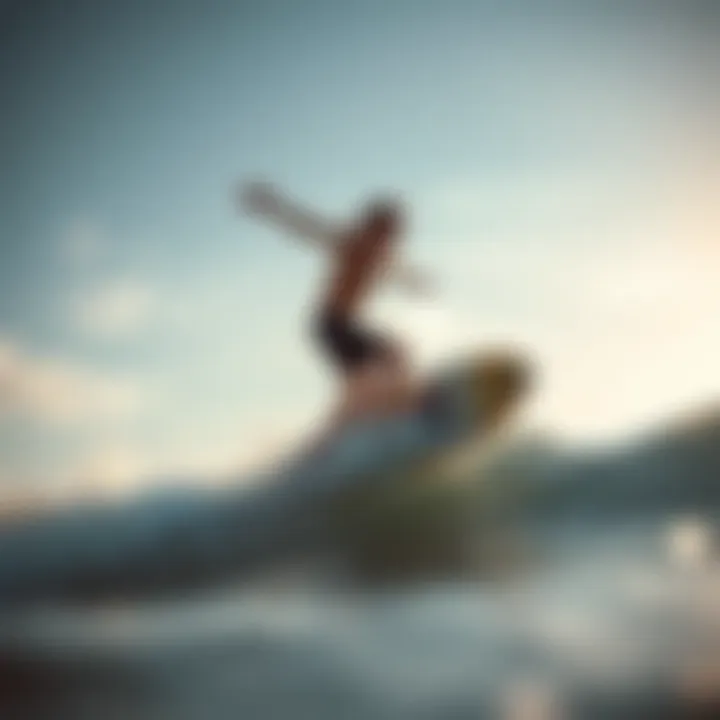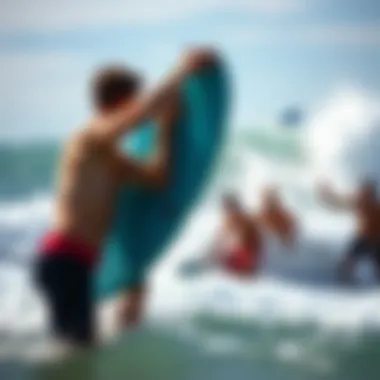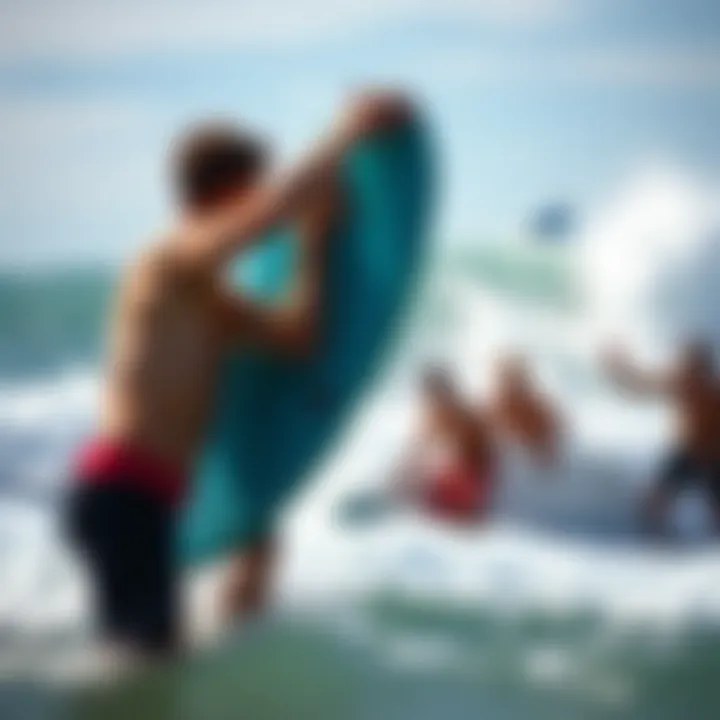Enhancing Surfing Skills through Effective Pop-Up Drills


Intro
Surfing, an exhilarating dance on water, requires not just bravery but also finesse, balance, and agility. While many folks imagine themselves riding epic waves, it’s often the foundational skills that determine how close they get to those dreams. Among the myriad of techniques that surfers hold dear, pop-up exercises stand out as among the most crucial. By perfecting these maneuvers, surfers at any level can dramatically enhance their performance.
The beauty of pop-up exercises is that they serve as a bridge between theoretical knowledge and practical application. Whether you're just starting out or aiming to polish your skills, understanding the mechanics of popping up can lead to a more rewarding surf experience. Not only do they improve balance, but they also refine your agility, thereby setting the stage for tackling larger waves with confidence and poise.
Delving deeper into this topic, it's vital to explore not just how to execute these drills, but also the underlying principles that make them effective. This article navigates through various aspects of pop-up exercises, including expert insights, safety protocols, and the gear that can amplify your training.
The journey to mastering surfing through pop-up techniques isn’t just technical; it’s about cultivating a deeper connection with the board and the ocean. Let’s dive in and elevate your surfing skills to new heights!
Understanding the Basics of Surfing
Before a surfer can truly harness the ocean’s energy, it’s essential to grasp the fundamental concepts behind this sport. Understanding the basics of surfing does not merely enhance one’s ability to ride the waves; it lays down the very foundation for advanced techniques, including the critical pop-up exercise. The insights gained from mastering core concepts can pave the way for improved performance and greater enjoyment in the water.
The Importance of Core Stability
Core stability acts as the linchpin in the surfer's skill set. It's not merely about balance on the board; rather, it encompasses the entire body's alignment and finesse in movement. When you’re out there on a wave, what keeps you afloat amidst the ebbs and flows? It’s the strength of your core that allows for those fluid transitions, solid landing, and, importantly, safe wipeouts.
To put this into perspective, consider a tightrope walker — every slight shift in their body can lead to a tumble. Similarly, in surfing, a stable core ensures that surfers can maintain their position and adjust swiftly. Improved core strength results in a lower center of gravity, which naturally enhances balance. This improved stability through the core makes transitioning to the pop-up a much more instinctive and crisp motion, leading to an efficient catch of those beloved waves.
Fundamental Surfing Techniques
Every adept surfer begins with fundamental techniques. These methods range from positioning oneself correctly on the board, understanding wave dynamics, to the pivotal stance each rider adopts.
- Paddling: It’s vital to develop a strong and efficient paddling technique. This involves proper hand placement in the water and rhythm to glide effectively.
- Stance: Finding the right stance on the board—either regular or goofy—is an essential element. This affects one’s balance, speed, and how they maneuver when catching waves.
- Pop-Up: The pop-up is arguably the most critical move to master, as it’s the transition from lying prone on the board to standing upright. Think of it as the moment when a magician pulls off the big reveal; the effectiveness of this skill can often determine a surf session’s success.
- Turning: Surfing is not just about going straight; turning is necessary to navigate the waves and ride with control. Mastering cutbacks and bottom turns will enhance your overall performance.
"Your foundation in surfing is like the roots of a tree. The stronger they are, the higher and longer you can reach the sky on your journey across the waves."
Understanding these foundational elements not only builds a well-rounded surfer but sets the stage for integrating pop-up exercises effectively. Those looking to advance their skills will find that a rock-solid grasp of these fundamental techniques makes the surfing experience infinitely more rewarding.
Preamble to Pop-Up Exercises
Pop-up exercises play a crucial role in the development of surfing skills, and it is essential to grasp their significance as we delve into this topic. These exercises form the backbone of the transition from paddling to standing on the surfboard, making them indispensable for surfers at all stages of their journey. Understanding the mechanics and benefits of pop-up exercises allows athletes to refine their technique, increase agility, and enhance their overall performance.
In surfing, being able to quickly and effectively pop up onto your board can mean the difference between riding the wave successfully or falling flat into the water. This agility is vital not only for performance but also for safety, as it helps surfers adjust timely to changing wave conditions. Additionally, mastering this transition builds confidence, which is embodied in every successful riding moment.
When discussing pop-up exercises, it's worth noting several core elements that contribute to their effectiveness. Firstly, these exercises encourage muscle memory development. With repetition, the body starts to recognize the movements required to achieve a smooth, controlled pop-up. This consistency leads to a more fluid practice on the water. Moreover, they focus on core stability—a fundamental aspect of surfing, enabling surfers to maintain balance while riding unpredictable waves.
Let's explore the definition and purpose of these exercises, as well as elucidate on how they contribute to overall surfing performance.
Definition and Purpose
Pop-up exercises entail a sequence of movements designed to replicate the action of transitioning from a prone position on the surfboard to a standing stance. The essence of the pop-up is to rise swiftly and seamlessly, minimizing any disruption on the wave. While specific variations exist, the basic action requires a certain level of strength, balance, and timing.
The primary purpose of pop-up exercises is to develop the necessary skills to execute this move consistently. Surfing requires not just physical prowess but also mental acuity—an awareness of how the body interacts with the board and the water. Effective pop-up drills create a bridge between these two elements, allowing surfers to internalize the mechanics involved.
These exercises also have broader implications beyond just the physical mechanics. They engage the mind and body in synchronized action, fostering a deeper understanding of balance and positioning. This harmony is what distinguishes proficient surfers from their less experienced counterparts.
How Pop-Up Exercises Contribute to Surfing Performance
Integrating pop-up exercises into regular training routines can yield substantial dividends for aspiring and seasoned surfers alike. One of the most immediate benefits is an improved reaction time. Surfers often face unexpected changes, whether it's a shift in wave direction or varying strength. A well-practiced pop-up enables a surfer to respond swiftly, minimizing the risk of wipeouts.
In addition, the exercises enhance overall body strength, particularly in the core region. This muscular development directly correlates to better balance and control when performing aerial maneuvers or turns. Surfers find themselves performing with greater confidence and fluidity, elevating their enjoyment and engagement with the sport.
Another significant aspect is the boost in agility. When surfers practice these drills, they're not just improving their stand-up technique; they're also honing their body’s ability to adjust and realign quickly during their rides. This agility becomes particularly vital when navigating through various wave conditions, allowing for smoother transitions and quicker adaptations.
Types of Pop-Up Exercises


Understanding the varied types of pop-up exercises is fundamental for any surfer aiming to enhance their skills on the board. Each drill offers distinct benefits that cater to different levels of proficiency and training needs. This section breaks down these exercises, focusing on methods that can be leveraged for effective performance improvement.
The Standard Pop-Up Drill
The standard pop-up drill serves as the cornerstone of most surfing regimes. This exercise is simple yet incredibly effective. It mimics the action of transitioning from lying on the board to standing swiftly, which is critical in surfing.
To perform the drill, start by lying flat on your stomach on a surfboard placed on the sand or a mat. Your hands should be under your shoulders, much like the push-up position. Here’s how it goes: push off from your hands, bringing your feet underneath you while swivelling into a standing position, typically facing forward. The knees should come up first, leveraging them to lift the body high enough to place the feet beneath the body’s center of gravity.
Regular practice of this drill helps engage the core and arm muscles effectively. It’s a great workout for building muscle memory, so the movement becomes second nature when you’re out in the water. Not only does it improve balance, but it also engages the right muscle groups to elevate overall performance.
Variations for Advanced Surfers
Once you’ve mastered the standard drill, you might find that your practice needs a bit more sugar to keep things interesting and effective. Advanced surfers can incorporate variations that challenge their strength, agility, and adaptability.
One variation entails adding a rotational element to the pop-up. From the standard position, while popping up, the surfer twists their body mid-transition to face either side, emulating the need to adjust quickly when taking off on a wave. Another involves incorporating a jump before landing in the stance, effectively mimicking the need to adjust your balance during unpredictable surf conditions.
These advanced adaptations not only help improve strength and coordination but also ensure surfers can respond to the fluidity of real wave scenarios. Engaging in diverse drills keeps practice fresh and relevant, and can make a world of difference in competitive settings.
Incorporating Equipment for Enhanced Training
For those looking to elevate their training further, incorporating specialized equipment can bring significant benefits to pop-up exercises. Using tools like resistance bands or balance boards can add layers of complexity. For instance, a balance board challenges the surfer's stability while they perform pop-ups, largely simulating the movement and balance required on water.
Another common approach is utilizing surf trainers, which are essentially foam pads or bounce devices designed to mimic the surf conditions without needing to hit the waves. Practicing pop-ups on these trainers provides instant feedback on balance and form, making it easier to troubleshoot and perfect every facet of the movement.
"Training with equipment not only reinforces core muscles but also introduces elements of instability, which is crucial for mastering the pop-up."
By regularly mixing these elements into your routine, you can vastly improve both the strength and precision required for a successful surf. Pavement to ocean, it's about carrying every bit of practice forward.
Key Benefits of Pop-Up Exercises
Pop-up exercises are more than just a set of actions performed on dry land; they play a pivotal role in shaping a surfer's proficiency in the waves. Mastering these drills can enhance essential surfing skills and lead to noticeable improvements on the board. This section discusses the value of such exercises and highlights their core advantages – not only for aspiring surfers but even for seasoned athletes seeking to hone their edge.
Improving Reaction Time and Reflexes
In the fast-paced environment of surfing, having quick reaction times can make all the difference between catching the perfect wave or wiping out in a split second. Pop-up exercises sharpen reflexes by activating the muscles and preparing the body for sudden bursts of activity.
During practice, the body adapts to rapid movements, becoming more attuned to external stimuli. For instance, when a surfer practices popping up quickly after paddling out, they simulate the swift motion needed when encountering an incoming wave. This training transfers into the ocean, enabling surfers to respond almost instinctively to changing wave conditions. Regularly incorporating pop-up exercises also contributes to neuromuscular coordination, enabling a smoother transition from rest to action.
Building Muscle Memory
Muscle memory is a crucial benefit of consistent pop-up practice. Each repetition reinforces the neural pathways involved in the action, making it easier for surfers to perform the act of rising from their bellies to their feet with speed and accuracy. Over time, this process transforms what once felt like a challenging maneuver into something that feels almost second nature.
To cultivate muscle memory, surfers should focus on maintaining consistent form during training. It’s essential to slow down and break the movement into manageable increments while ensuring that the stance remains stable. This deliberate practice helps embed the mechanics of popping up into the muscle memory, leading to better performance during actual surfing. Practicing on different surfaces, such as a balance board or even grass, can further enhance the effectiveness of this training.
Enhancing Agility and Balance
Agility and balance are the twin pillars of successful surfing. Pop-up exercises cultivate these qualities through repeated practice that mirrors the demands faced in the water. When performed regularly, these drills can significantly improve a surfer's ability to adjust their weight and position dynamically in response to their environment.
The key to improving these skills lies in the variability of practice. Surfers can mix in various forms of the pop-up drill to train their balance on unstable surfaces or even during strength exercises like yoga or pilates. Here’s a good way to integrate these elements into a training routine:
- Use uneven surfaces: Practice pop-ups on a balance board to simulate instability.
- Dynamic movements: Integrate lateral movements after each pop-up to further challenge stability.
- Exercises such as lunges or squat jumps post-pop-up can also help to improve the surfer's readiness for unexpected changes during wave riding.
"Incorporating pop-up exercises into your sea training can unlock new levels of performance, allowing you to dance with the waves like never before."
Each of these benefits – from quicker reactions to the ability to stay balanced on a tricky board – reveals how integral pop-up exercises are to any surfing regimen. Practicing such drills not only equips surfers with essential skills but also instills a solid foundation for consistent improvement on the waves.
Incorporating Pop-Up Exercises into Training


When it comes to surfing, the journey toward improving skills never truly ends. Among the many training methods, incorporating pop-up exercises stands out as a way to not just refine technique, but also to elevate overall performance on the water. This section focuses on how these exercises can be seamlessly integrated into your training routine, ensuring that you maximize their benefits.
Creating a Balanced Training Routine
A well-rounded training routine is like a finely tuned surfboard – it needs to be just right to perform well. When you include pop-up exercises, it’s essential to consider a balanced approach that incorporates strength, flexibility, and endurance. Think of it this way: you wouldn't jump into the ocean without first ensuring you understand how to paddle effectively, so why would you practice your pop-ups in isolation?
A balanced routine means that you’ll want to include:
- Strength Training: Focus on exercises that build core stability. Planks, squats, and push-ups can significantly enhance the muscle groups utilized during a pop-up.
- Flexibility Drills: Incorporating stretches can improve your range of motion. Yoga is an excellent option as it promotes both flexibility and mental focus, which is critical in surfing.
- Agility and Cardio Exercises: These help with quick foot movement needed post-popping up. Box jumps or shuttle runs can serve well in achieving this.
When you achieve a harmony between these aspects, pop-up drills become a natural part of your practice instead of a standalone task.
Setting Realistic Goals for Practice
Setting goals is crucial, but they need to be as realistic as a surfer who's aware of the tides. Before diving headfirst into pop-up drills, assess your current abilities. If you're just starting out, aiming to nail a perfect pop-up on your first day might be unrealistic. Instead, you might focus on the mechanics of going from lying down to feet on the board in a controlled manner.
Some suggestions for setting achievable goals include:
- Starting Small: It could be as simple as mastering the timing of your push-up sequence. Once that's dialed in, you can move on to performing it on a mat or a soft surface to simulate a surfboard.
- Incremental Progress: Celebrate each small victory. Perhaps today you managed to pop up in a timely manner, but tomorrow your goal could be to maintain balance for longer.
- Tracking Improvement: Keep a log of your practice sessions. Note what felt good and what didn’t. Was it easier today because you did a few extra stretches? Keeping track reveals your progress over time.
With realistic goals, you maintain motivation and provide a clearer path toward improving your surfing skills.
"The road to mastery is paved by incremental progress - celebrate each step along the way."
Incorporating pop-up exercises into a balanced training routine, with clear and achievable goals, is the core of boosting your surfing prowess. This approach not only cultivates skill but also nurtures a passion for the sport, resulting in a deeper connection to the waves.
Common Mistakes to Avoid
When looking to maximize your surfing skills through pop-up exercises, avoiding common pitfalls is crucial. This section dives into two significant mistakes: incorrect stance and form, as well as neglecting core strength training. Whether you are a beginner learning the ropes or a seasoned surfer refining your technique, recognizing these missteps can both save you from injury and propel your surfing performance to new heights.
Incorrect Stance and Form
An incorrect stance can be the undoing of even the most enthusiastic beginner. Often, surfers focus so much on the pop-up itself that they neglect how they position their bodies once standing on the board. A poor posture not only affects balance but can also lead to falls, diminishing the joy of riding the waves. For example, if your feet are too close together or too far apart, it throws off your center of gravity and can make catching a wave feel like an uphill battle. Here are a few key points to keep in mind:
- Foot Placement: Your feet should be shoulder-width apart when you pop up. This creates a solid base and improves stability.
- Knees Bent: Keep your knees slightly bent for better responsiveness to the wave's movements. Locked knees can quickly lead to stumbles.
- Chest Up: Maintain an upright torso. If you're hunched over, you'll find it harder to react to shifts in balance, potentially sending you tumbling into the water.
Ultimately, practicing proper form during pop-up drills paves the way for smoother transitions on the water. A clear, conscious stance allows you to absorb the dynamics of waves more effectively.
"If you stand like a surfer, you'll ride like a surfer."
Neglecting Core Strength Training
The core is the powerhouse of the body, and ignoring it is a mistake many surfers make in their training. Core strength is fundamental for all athletic activities, particularly for stabilizing your movement while on the surfboard. A strong core supports everything from balance to endurance.
Without proper core engagement, surfers may struggle to maintain stability when they paddle or pop up. Here are some considerations to remember when integrating core training into your routine:
- Incorporate Plank Variations: Planks not only target your abs but also engage your shoulders and lower back. Try side planks for a twist on your regular routine.
- Russian Twists for Agility: Practicing rotational movements helps to enhance your ability to shift weight quickly when balancing on a wave.
- Look Beyond Sit-ups: Exercises like deadlifts or kettlebell swings can promote overall core stability while also building strength in other muscle groups.
By making core strength training a priority, surfers can see drastic improvements in their overall control and adaptability when riding waves. The integration of these elements into your training ensures that you're building the necessary foundation for maximizing your surfing potential.
Measuring Progress and Performance
Measuring progress and performance in surfing is not just about the accolades or the trophies; it’s about identifying where you stand on your surfing journey and recognizing opportunities for growth. When it comes to mastering pop-up exercises, tracking how these drills affect your performance can illuminate the path to improvement. It’s vital to set benchmarks, adjust practices, and reflect on feedback to truly understand your evolution as a surfer.
Utilizing Video Analysis
One of the most effective means of tracking your surfing skills is through video analysis. Capturing your movements allows you to see where the rubber meets the road. Your stance, timing, and technique can all be scrutinized frame by frame. Watching yourself surf can be an eye-opener; many surfers are often unaware of subtle misalignments or inefficient movements until they see them on screen.


Benefits of Video Analysis
- Objective Feedback: Video offers an unbiased view of your performance. It's something you can look back at and assess.
- Visual Learning: Many individuals are visual learners. Seeing a replay can help consolidate techniques in your mind.
- Progress Tracking: Recording sessions over time can give a tangible measure of how your skills are evolving.
With apps and tools available, video analysis is accessible. You might use your smartphone or a GoPro to capture your practice sessions and analyze them at your leisure. It’s about crafting a routine where reviewing footage becomes part of your growth strategy.
"A picture is worth a thousand words, but a video can show you the whole story."
Feedback from Coaches and Peers
Another crucial component is seeking feedback from coaches and even peers. This is not merely about getting compliments or critiques; it’s about fostering an environment of constructive growth. Coaches often possess a wealth of knowledge that can help refine your techniques, while friends might catch nuances that you might overlook.
Key Considerations for Effective Feedback
- Be Open-Minded: Taking criticism can sting, especially in a sport as personal as surfing. However, feedback often holds the key to unlocking your next level.
- Engage in Dialogue: Instead of passively receiving critiques, engage with your coaches or friends. Asking specific questions can yield more valuable insights.
- Set Recurring Check-Ins: Regular feedback sessions help maintain focus on your goals and celebrate the small victories along the way.
It's essential to cultivate relationships with those in your surfing community. This doesn’t just improve your individual skill set but also nurtures a collective growth atmosphere, turning your progress into a shared adventure.
Adapting Pop-Up Exercises for Different Environments
To harness the full potential of pop-up exercises, it's essential to adjust them based on your surroundings. The nature of your practice space can significantly impact the effectiveness of your training. Recognizing the differences between land and water practice, along with adapting techniques for various wave conditions, can significantly enhance your surfing proficiency.
Practice on Land vs. Water
Training on land provides a stable surface, making it easier to focus on technique without the additional challenge of waves. Common practice spaces include gyms, living rooms, or even backyard grass. Here, you can concentrate on your form, drill the mechanics of the pop-up, and develop muscle memory. Some key points for practicing on land include:
- Focus on Technique: Since the ground won't shift beneath you, you can work on the precision of your movements. Getting the foot placement right is a common place to start.
- Use Props: Incorporate balance boards or even just a towel to simulate the surface of a board. These tools are great for developing stability.
- Simulated Conditions: Visualize the transition from lying flat to standing up. Use mirrors or a video to critique your form. It's an opportunity to analyze your movements without the rush of actual surfing.
In contrast, practicing on water presents its own set of unique challenges and benefits. The dynamic environment requires surfers to adapt quickly, simulating real-world surfing conditions. Here’s how to make the most of water practice:
- Embrace the Instability: Water isn't forgiving; you won’t just pop up and stand. Learning to transition from lying down to standing while balancing on a moving surface is vital. This enhances your ability to adjust during actual rides.
- Feel the Flow: Catching a wave provides a unique sensation and excitement that can’t be replicated on land. This is when your instincts sharpen. Each wave pushes your ability to react, adding a layer of complexity.
- Controlled Drills: Start in gentle waves to get a feel for the water. Gradually increase the size of the waves as you gain confidence and adaptability.
Adjusting for Wave Conditions
Not all waves are created equal, and understanding how to adjust your pop-up exercises based on varying wave conditions is crucial for surfers. Different scenarios will demand different techniques and mental approaches. Here’s a breakdown of considerations:
- Small, Gentle Waves: These are great for beginners and allow ample time to get your pop-up right. Practice a slow and controlled transition with more focus on getting up smoothly. You want to build confidence without the distraction of large impacts.
- Moderate Waves: As conditions pick up, the challenge increases. These waves require quicker reflexes and adaptable techniques. The pop-up must transition from a grounded motion to a rapid execution. Drill pop-ups repeatedly to build muscle memory under duress.
- Big and Challenging Waves: For advanced surfers tackling larger sets, the emphasis shifts to agility and balance. The energy of the waves changes dramatically, so you’ll need to have perfected your pop-up drill first on calmer waters. When you're ready, time your pop-ups in high-energy conditions to ensure you're able to handle the momentum.
"Adaptability not only defines your surfing skill but also ensures your safety on the board. Know your environment and modify your training to match the conditions for optimal improvement."
Overall, understanding how to adapt your practice can reshape your approach to surfing. It connects the technical aspects of the sport to the unpredictable nature of the ocean, creating a well-rounded surfer focused on continual improvement.
Epilogue
In this fast-paced world of surfing, maximizing your skills is not just a goal; it's a way of life. The concluding section of this article ties together the vital elements surrounding pop-up exercises, emphasizing their significance not only in mastering the technique but also in fostering a lifelong passion for surfing. Engaging in pop-up drills goes beyond just learning to stand on a board; it lays the foundation for better balance, agility, and muscle coordination—essential ingredients in a surfer's recipe for success.
Reinforcing Skills for Lifelong Surfing
Lifelong surfers often speak about the joys and challenges encountered on the waves, but what underpins these experiences? It’s the strong core skills developed through rigorous practice, including pop-up exercises. Reinforcing these skills involves consistently revisiting the basics, regardless of experience levels.
Consider this: every time you pop up, you’re not just getting ready to ride the wave. You’re reinforcing your core strength, enhancing your balance, and improving your reflexes, all of which contribute to overall performance. Many seasoned surfers say that their most enjoyable moments come from mastering those small but essential movements—like that perfect pop-up that sets the tone for the ride.
- Practice Consistency: Just as a musician perfects a scale, surfers must repeat their drills to build muscle memory. This leads to instinctual movement, crucial when caught off guard by sudden changes in wave conditions.
- Mindset Matters: Engaging in these pop-up exercises with a positive mindset aids in reinforcing skills. Visualize success as you practice, creating a mental image that can translate to physical success.
Encouraging Continuous Improvement
Continuous improvement in surfing is akin to the ebb and flow of the ocean—you’re always navigating different conditions and challenges. Embracing the mindset of ongoing development can be the difference between staying stagnant and truly thriving.
Incorporating pop-up exercises into your daily routine serves as a springboard for improvements. It’s not just about getting the drill right; it’s about pushing your limits. Variations of pop-up exercises can keep your training dynamic and tailored to your goals.
- Set Specific Goals: Whether it’s increasing the speed of your pop-up or refining your stance, having clear objectives allows you to track progress efficiently. Keeping a log helps visualize your improvements over time.
- Solicit Feedback: Engaging with coaches or fellow surfers can provide insights that self-assessment might overlook. Outside perspectives can illuminate areas for refinement.
"The ocean is a classroom, and each wave brings a lesson. Every surf session is an opportunity to learn, adapt, and grow."
As you embark on or continue your surfing journey, remember: the commitment to refining skills through exercises like pop-ups leads to a deeper appreciation for the sport itself. Embrace the waves, cherish the process, and never lose sight of the joy that surfing brings. The journey is ongoing, as is the quest for improvement—may it be as endless as the horizon.







